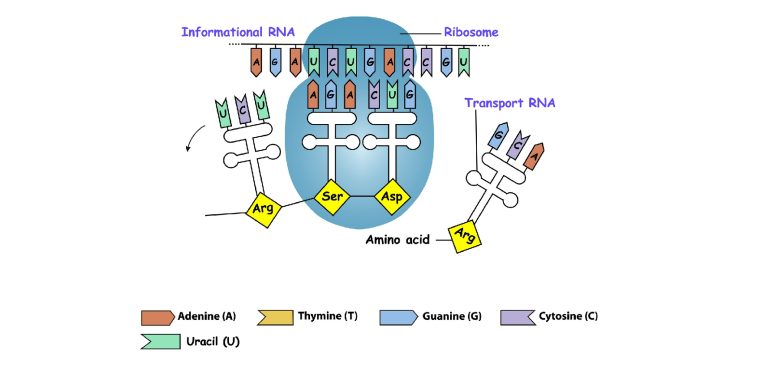[Originally published as Universal Genetic Code? No!]
Besides my review of the book Shadow of Oz, I wanted to write a separate article about one point that he makes in chapter 6, which is entitled “Biological Evolution.” He says:
To date, the National Center for Biotechnology Information (NCBI), which houses all published DNA sequences (as well as RNA and protein sequences), currently acknowledges nineteen different coding languages for DNA…
He then references this page from the NCBI website.
This was a shock to me. As an impressionable young student at the University of Rochester, I was taught quite definitively that there is only one code for DNA, and it is universal.¹ This, of course, is often cited as evidence for evolution. Consider, for example, this statement from the Biology Encyclopedia:
For almost all organisms tested, including humans, flies, yeast, and bacteria, the same codons are used to code for the same amino acids. Therefore, the genetic code is said to be universal. The universality of the genetic code strongly implies a common evolutionary origin to all organisms, even those in which the small differences have evolved. These include a few bacteria and protozoa that have a few variations, usually involving stop codons.
Dr. Rossiter points out that this isn’t anywhere close to correct, and it presents serious problems for the idea that all life descended from a single, common ancestor.
How the DNA Code Works
To understand the importance of Dr. Rossiter’s point, you need to know how a cell makes proteins.
The basic steps of the process are illustrated in the image at the top of this post. The “recipe” for each protein is stored in DNA, and it is coded by four different nucleotide bases (abbreviated A, T, G, and C). That recipe is copied to a different molecule, RNA, in a process called transcription.
During that process, the nucleotide base U is used instead of T, so the copy has A, U, G, and C as its four nucleotide bases. The copy then goes to the place where the proteins are actually made, which is called the ribosome. The ribosome reads the recipe in units called codons. Each codon, which consists of three nucleotide bases, specifies a particular amino acid. When the amino acids are strung together in the order given by the codons, the proper protein is made.
The genetic code tells the cell which codon specifies which amino acid. For example, one codon is spelled with AUG. According to the supposedly universal genetic code, those three nucleotide bases in that order code for one specific amino acid: methionine. Another codon (CCG) is supposed to code for the amino acid proline. Each possible three-letter sequence (each possible codon) codes for a specific amino acid, and the collection of all those possible codons and what they code for is often called the genetic code.
Now, once again, according to the Biology Encyclopedia (and many, many other sources), the genetic code is nearly universal. Aside from a few minor exceptions, all organisms use the same genetic code, which points strongly to the idea that all organisms evolved from a common ancestor. However, according to the NCBI, that isn’t even close to correct. There are all sorts of exceptions to this “universal” genetic code, and I would think that some of them result in serious problems for the hypothesis of evolution.
An Example of Different DNA Languages
Consider, for example, the vertebrate mitochondrial code and the invertebrate mitochondrial code. In case you didn’t know, many cells actually have two sources of DNA. The main source of DNA is in the cell’s nucleus, so it is called nuclear DNA. However, the kinds of cells that make up both vertebrates and invertebrates also have DNA in their mitochondria, small structures that are responsible for making most of the energy the cell uses to survive. The DNA found in mitochondria is called mitochondrial DNA.
Now, according to the hypothesis of evolution, the kinds of cells that make up vertebrates and invertebrates (called eukaryotic cells) were not the first to evolve. Instead, the kinds of cells found in bacteria (called prokaryotic cells) supposedly evolved first. Then, at a later time, one prokaryotic cell supposedly engulfed another, but the engulfed cell managed to survive. Over generations, these two cells somehow managed to start working together, and the engulfed cell became the mitochondrion for the cell that engulfed it. This is the hypothesis of endosymbiosis, and despite its many, many problems, it is the standard tale of how prokaryotic cells became eukaryotic cells.
However, if the mitochondria in invertebrates use a different genetic code from the mitochondria in vertebrates, and both of those codes are different from the “universal” genetic code, what does that tell us?
The evolutionists take it to mean that the eukaryotic cells that eventually evolved into invertebrates must have formed when a cell that used the “universal” code engulfed a cell that used a different code. However, the eukaryotic cells that eventually evolved into vertebrates must have formed when a cell that used the “universal” code engulfed a cell that used yet another different code. As a result, invertebrates must have evolved from one line of eukaryotic cells, while vertebrates must have evolved from a completely separate line of eukaryotic cells. But this isn’t possible since evolution depends on vertebrates evolving from invertebrates.
Now, of course, this serious problem can be solved by assuming that while invertebrates evolved into vertebrates, their mitochondria also evolved to use a different genetic code. However, I am not really sure how that would be possible. After all, the invertebrates spent millions of years evolving, and through all those years, their mitochondrial DNA was set up based on one code. How could the code change without destroying the function of the mitochondria?
At a minimum, this adds another task to the long, long list of unfinished tasks necessary to explain how evolution could possibly work. Along with explaining how nuclear DNA can evolve to produce the new structures needed to change invertebrates into vertebrates, evolutionists must also explain how, at the same time, mitochondria can evolve to use a different genetic code!
In the end, it seems to me that this wide variation in the genetic code deals a serious blow to the entire hypothesis of common ancestry, at least the way it is currently constructed. Perhaps that’s why I hadn’t heard about it until reading Dr. Rossiter’s excellent book.
Addition
After speaking with a biology professor for whom I have a lot of respect, I need to make an addendum. She says that nowadays, the term “universal genetic code” doesn’t necessarily mean that every organism uses the same set of codons for the same amino acids. One could say that the genetic code is universal in the sense that all organisms use three nucleotide bases to define an amino acid, the codes can all be translated at the ribosome, etc. I still think that these alternate genetic codes argue against evolution, but it is important to note that some evolutionists use the term “universal” without implying that the codons are all the same among all organisms.







